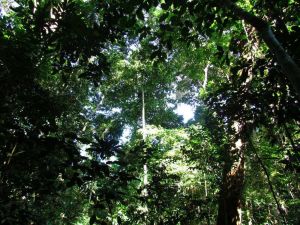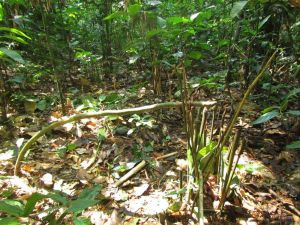Kokolopori Bonobo Reserve
Central Africa > Democratic Republic of the Congo > Kokolopori Bonobo Reserve
Français | Português | Español | Bahasa Indonesia | Melayu
Summary
- Bonobos (Pan paniscus) are present in Kokolopori Bonobo Reserve.
- The population size is unknown.
- The population trend is unknown.
- The site has a total size of 4,850 km².
- Key threats to bonobos are hunting and conversion of natural habitat for agriculture.
- Conservation activities have focused on providing benefits to the local community.
Site characteristics
The site was established as a community-based nature reserve in 2009 (Surbeck, Coxe & Lokasola 2017). Besides bonobos, the site is inhabited by various duiker species (e.g. blue duiker Cephalophus monticola, black-fronted duiker Cephalophus nigrifrons, bay duiker Cephalophus dorsalis and Peter’s duiker Cephalophus callipygus), monkeys (e.g. red-tailed monkeys Cercopithecus ascanius, Wolf’s mona monkey Cercopithecus wolfi and De Brazza’s monkey Cercopithecus neglectus), red river hogs (Potamochoerus porcus), sitatungas (Tragelaphus spekii), aardvarks (Orycteropus afer), tree pangolins (Phataginus tricuspis), golden cats (Felis aurata) and leopards (Panthera pardus).
Table 1. Basic site information for Kokolopori Bonobo Reserve
| Species | 'Pan paniscus |
| Area | 4,850 km² |
| Coordinates | Lat: 0.416667 , Lon: 22.966667 |
| Type of site | Non-protected area |
| Habitat types | Subtropical/tropical dry forest, Subtropical/tropical moist lowland forest, Wetlands (lakes, rivers, streams, bogs, marshes), Agricultural land, Subtropical/tropical heavily degraded former forest |
| Type of governance |
IUCN habitat categories Site designations
Ape status
Table 2. Ape population estimates reported for Kokolopori Bonobo Reserve
| Species | Year | Occurrence | Encounter or vistation rate (nests/km; ind/day) | Density estimate [ind./ km²] (95% CI) | Abundance estimate (95% CI) | Survey area | Sampling method | Analytical framework | Source | Comments | A.P.E.S. database ID |
|---|---|---|---|---|---|---|---|---|---|---|---|
| Pan paniscus | Unknown |
Threats
Table 3. Threats to apes reported for Kokolopori Bonobo Reserve
| Category | Specific threats | Threat level | Description | Year of threat |
|---|---|---|---|---|
| 1 Residential & commercial development | Absent | |||
| 6 Human intrusions & disturbance | Absent | |||
| 7 Natural system modifications | Absent | |||
| 8 Invasive & other problematic species, genes & diseases | Absent | |||
| 9 Pollution | Absent | |||
| 10 Geological events | Absent | |||
| 12 Other threat | Absent | |||
| 5 Biological resource use | 5.1 Hunting & collecting terrestrial animals | High (more than 70% of population affected) | Hunting, mainly with snares and traps, but also guns (Lucchesi pers. comm. 2020). | Ongoing (2020) |
| 3 Energy production & mining | 3.2 Mining & quarrying | Low (up to 30% of population affected) | Artisanal gold mining next to rivers, low intensity and small scale (Lucchesi pers. comm. 2020). | Ongoing (2020) |
| 2 Agriculture & aquaculture | 2.1 Annual & perennial non-timber crops | Medium (30-70% of population affected) | Slash-and-burn agriculture aimed at opening fields for self-sustenance (Lucchesi pers. comm. 2020). | Ongoing (2020) |
| 4 Transportation & service corridors | 4.1 Roads & railroads | Present (unknown severity) | Wide dirt road crossing bonobo ranges (Lucchesi pers. comm. 2020). | Ongoing (2020) |
| 11 Climate change & severe weather | Unknown |
Conservation activities
The establishment of the reserve resulted as a collaborative effort among the DRC government, the ICCN, the Bonobo Conservation Initiative, the local NGO Vie Sauvage, and the residents of Kokolopori (BCI 2020).
Table 4. Conservation activities reported for Kokolopori Bonobo Reserve
| Category | Specific activity | Description | Implementing organization(s) | Year of activity |
|---|---|---|---|---|
| 7 Economic & other incentives | 7.2 Provide non-monetary benefits to local communities for sustainably managing their forest and its wildlife (e.g., better education, infrastructure development) | The BCI and Vie Sauvage initiated the Bonobo Health Clinic, funded by the Indigo Foundation. The Bonobo Health Clinic provides health-care to the local community (Indigo Foundation 2020). The Kokolopori Bonobo Research Project also supports local education by constructing schools in the surrounding communities. | 2007-Ongoing (2020) |
Conservation activities list (Junker et al. 2017)
Challenges
Table 5. Challenges reported for Kokolopori Bonobo Reserve
| Challenges | Specific challenges | Source | Year(s) |
|---|---|---|---|
| Not reported |
Enablers
Table 6. Enablers reported for Kokolopori Bonobo Reserve
| Enablers | Specific enablers | Source | Year(s) |
|---|---|---|---|
| 1 Site management | |||
| 2 Resources and capacity | |||
| 3 Engaged community | |||
| 4 Institutional support | |||
| 5 Ecological context | |||
| 6 Safety and stability |
Research activities
The Kokolopori Bonobo Research Project explores the behavioural diversity and feeding ecology of the bonobo population in Kokolopori. The research team has fully habituated two bonobo groups, which are followed on a daily basis since 2016. In 2018, the team also started to habituate and follow a third bonobo group. The habituation of multiple neighbouring bonobo groups in the site has also provided a unique opportunity for the study of within- and between-group relationships in bonobos.
Documented behaviours
Table 7. Behaviours documented for Kokolopori Bonobo Reserve
| Behavior | Source |
|---|---|
| Bonobo cannibalism | Tokuyama et al. 2017 |
| Duiker, squirrel and anomalure hunting | Samuni, Wegdell & Surbeck 2020 |
| Truffle feeding | Lucchesi pers. comm. |
Exposure to climate change impacts
External links
Bonobo Conservation Initiative - Kokolopori
Relevant datasets
References
Bonobo Conservation Initiative (BCI). (2020, October 21). Kokolopori Bonobo Reserve.https://www.bonobo.org/programs/kokolopori-bonobo-reserve
Indigo Foundation (2020, October 21). Democratic Republic of Congo: Kokolopori and Vie Sauvage. https://www.indigofoundation.org/completed-projects/democratic-republic-of-congo-kokolopori
Samuni, L., Wegdell, F., & Surbeck. M. (2020). Behavioural diversity of bonobo prey preference as a potential cultural trait. eLife, e59191. DOI: 10.7554/eLife.59191
Surbeck, M., Coxe, S., & Lokasola, A. L. (2017). Lonoa: The Establishment of a Permanent Field Site for Behavioural Research on Bonobos in the Kokolopori Bonobo Reserve. Pan Africa News, 24(2), 13–15.
Tokuyama, N., Moore, D. L., Graham, K. E., Lokasola, A., & Furuichi, T. (2017). Cases of maternal cannibalism in wild bonobos (Pan paniscus) from two different field sites, Wamba and Kokolopori, Democratic Republic of the Congo. Primates, 58, 7–12.
Page created by: Leveda Cheng & Stefano Lucchesi Date: NA


